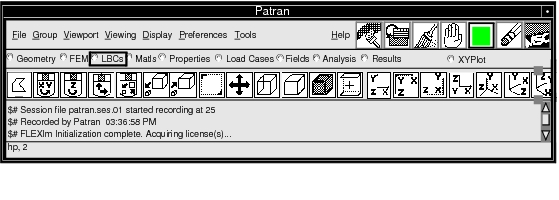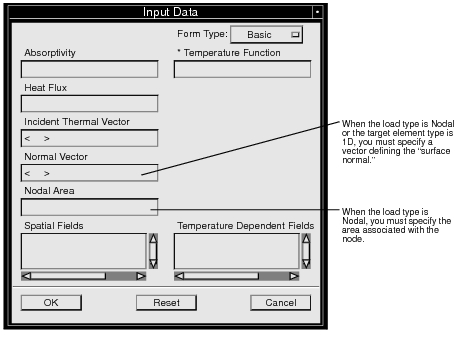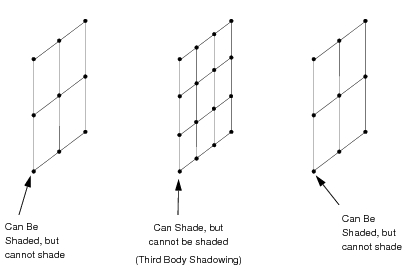XXXXXXXXXXXXXXXXXXXXXXXXXXXXXXXXXXXXXXXXXXXXXXXXXXXXXXXXXXXXXXXXXXXXXXXXXXXXXXXXXXXXXXXXXXXXXXXXXXXXXXXXXXXXXXXXXXXXXXXXXXXXXXXXXXXXXXXXXXXXXXXXXXXXXXXX''"> 3.6 Loads and Boundary Conditions
The Loads and Boundary Conditions form will appear when you select Loads/BCs from the main form. When you create a loads and/or boundary condition, there are several option menus. The selections made on the Loads and Boundary Conditions menu will determine which loads and/or boundary conditions form appears, and ultimately, which MD Nastran loads and/or boundary conditions will be created.
The following pages give an introduction to the Loads and Boundary Conditions form and details of all the loads and boundary conditions supported by the Patran MD Nastran Thermal Application Preference.
Loads and Boundary Conditions Form
This form appears when you select Loads/BCs from the main menu. The Loads/Boundary Conditions form provides options to create the various MD Nastran loads and/or boundary conditions. For a definition of full functionality, see
Loads and Boundary Conditions Form (p. 21) in the Patran Reference Manual.
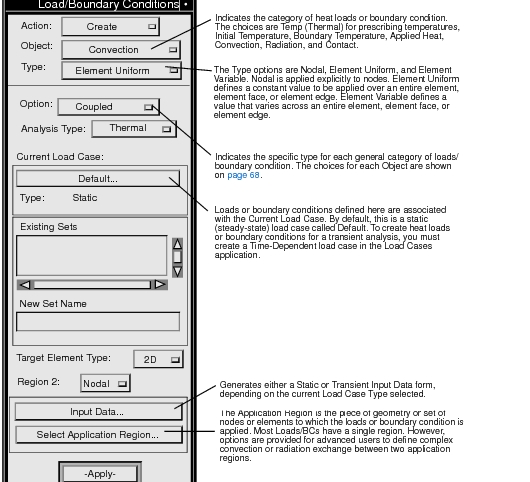
The following table outlines the options for creating MD Nastran thermal loads and boundary conditions:
Object | Option | Type | Target Element Type | Region 2 |
| | Nodal | -- | -- |
| | Nodal | -- | -- |
• Applied Heat | | Nodal | -- | -- |
Element Uniform Element Variable | 1D, 2D, 3D | -- |
| Nodal | -- | -- |
Element Uniform | 1D, 2D, 3D | -- |
| Nodal | -- | -- |
| Element Uniform | 1D, 2D, 3D | -- |
| • Total Heat | Element Uniform | 1D, 2D, 3D | |
• Convection | | Nodal | -- | -- |
Element Uniform | 1D, 2D, 3D | -- |
| Element Uniform | 1D | -- |
| Nodal | -- | Nodal |
Element Uniform | 1D, 2D, 3D | Nodal, 1D, 2D, 3D |
| Element Uniform | 1D | Nodal, 1D, 2D, 3D |
| Element Uniform | 1D, 2D, 3D | 1D |
| Element Uniform | 1D | 2D, 3D |
• Radiation | | Nodal | -- | -- |
Element Uniform | 1D, 2D, 3D | -- |
| Nodal | -- | Nodal |
Element Uniform | 1D, 2D, 3D | Nodal 1D, 2D, 3D |
| Nodal | -- | -- |
Element Uniform | 1D, 2D, 3D | -- |
• Contact | • Deformable • Rigid Body | Element Uniform | 1D, 2D, 3D | |
Input Data Forms--Basic and Advanced Options
Many of the input data forms have a Basic format and an Advanced format. The default is the Basic format, but you can change the format to Advanced using the option menu at the top of the form.
Many of the advanced forms contain a databox called Control Node ID. If an existing node is selected in this databox, the temperature at this node during the analysis is used as an implicit load multiplier, depending on the exact application.
Another advanced option is the Film Node ID that appears on forms for defining convection boundary conditions. This option allows an existing node to be selected. The temperature of this node during the analysis is used to define the temperature of the fluid used in determining the temperature-dependent fluid material properties involved in the calculation of the convection heat transfer coefficient.
Two Application Regions
Two application regions provide advanced options for convection and radiation boundary conditions with complex exchange mechanisms. Application Region 1 defines a convecting or radiating surface, while Application Region 2 specifies a set of nodes to which the heat is transferred.
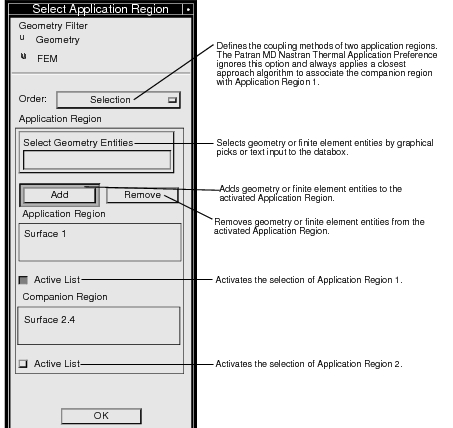
Note: | When applying any of the convection or radiation forms involving two application regions, both regions must use the same geometry filter. |
Surface Area
The total amount of heat radiated or convected from a surface or input from a heat source depends on the area of the surface. For nodal loads and boundary conditions, the nodal area must be defined explicitly. For faces of 2D or 3D elements, the area is calculated from the relative locations of the nodal points. For the edge of a shell element, the area is calculated from the nodal points location and the shell thickness. For general or tapered beam elements, the rod element, or the curved beam with general section, the area is calculated as:
For the rod or curved beam with pipe section, the area is calculated as:
For directional flux or radiation enclosure on 1D elements, the Patran MD Nastran forward translator will automatically calculate the projected area based on the normal vector specified for the given elements.
Spatial Dependence
Many of the quantities defined on the Loads/BCs forms are allowed to vary as a function of the model’s spatial coordinates. This variation is described by first defining a spatial field using the Fields application and then selecting this field from the Spatial Fields listbox on the Loads/BCs Input Data form. Creation of spatial fields is described in more detail in
Fields Forms (p. 204) in the Patran Reference Manual.
Temperature Dependence
Many of the quantities defined on the Loads/BCs forms are also allowed to vary as a function of temperature. An example is Convection Coefficient. The convection coefficient can take on different values depending on the surface or fluid temperatures at each point in the model. All quantities that are allowed to vary as a function of temperature have a second databox on the Loads/BCs Input Data form with the *Temperature Function label above it. This indicates that the temperature function multiplies the value in the databox to its immediate left (this value may be a constant or may come from a spatial field). Functions of temperature are described by defining a temperature-dependent field in the Fields application. To create this Field, you must set the Object to Material Property. You may then select the created field from the Temperature Dependent Fields listbox on the Loads/BCs Input Data form.
For convenience, if you have specified a temperature-dependent function but do not specify any value in the far left column, Patran will assign a default value of 1.0 to that databox.
Time Dependence
When the Current Load Case is Time Dependent (set from the Load Cases application), a time-dependent field listbox appears on the far right column of the Loads/BCs Input Data form. This column contains databoxes that allow the time dependence of the quantities in the far left column of the Input Data form to be defined. Just as for spatial and temperature dependencies, you must first create a time dependence in the Fields application. To create the field in the Fields application, you must set the Object to Non Spatial and the Method to Tabular Input. You must also define a set of time-load multiplier pairs. This field can then be selected from the Time Dependent Fields listbox on the Loads/BCs Input Data form.
For convenience, if you have specified a time-dependent function but do not specify any value in the far left column, Patran will assign a default value of 1.0 to that databox.
Temp(Thermal)
Forms associated with the Temp(Thermal) Object allow you to define nodal temperatures that remain constrained during the analysis. The Temp(Thermal) Input Data forms for steady-state (Static) and transient (Time Dependent) load cases are shown below.
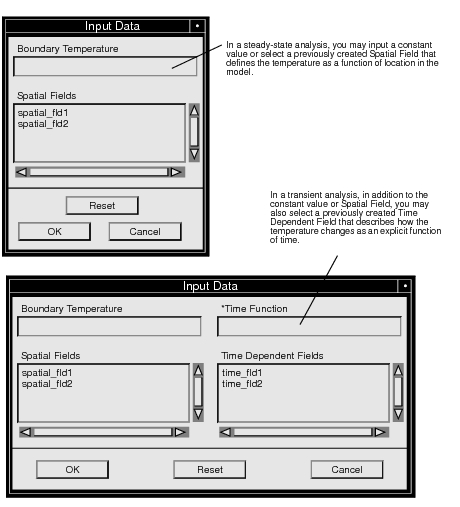
The input option is described in the table below.
Input Data | Dependence | Description |
Boundary Temperature | spatial, time | Defines temperature boundary conditions. |
Initial Temperature
Initial temperature is required in a time-dependent analysis. In a nonlinear steady-state analysis, initial temperatures are input as an initial guess to improve the convergence rate and often to provide initialization for the nonlinear iterative solution scheme.
As a user convenience, if most of the initial nodal temperatures are to be the same, you can define this temperature using the Default Init Temperature databox in the Solution Parameters form invoked from the Analysis application. Any initial temperatures defined using this Initial Temperature option in Loads/BCs will take precedence over the default value defined in the Analysis application. The Input Data form for Initial Temperature is very similar to the form for steady-state temperature shown above. The input option is described in the table below.
Input Data | Dependence | Description |
Initial Temperature | spatial | Defines initial condition temperatures for transient analysis. May also be used to define an initial guess in a nonlinear steady-state analysis. |
Applied Heat--Normal Fluxes
This option applies a heat flux either to nodes or elements on the surface of a body.
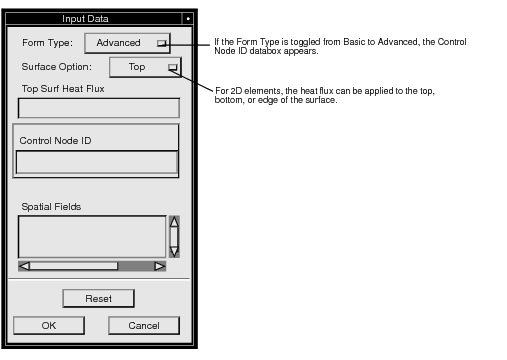
The following table describes the options for defining a heat flux.
Input Data | Dependence | Description |
Heat Flux | spatial, time | Defines a heat flux. |
[Top Surf, Bottom Surf, Edge] Heat Flux | spatial, time | When the Target Element Type on the main form is set to 2D, this databox appears to define a heat flux applied on the top, bottom, or edge of a boundary surface. |
Nodal Area | -- | Appears only when the LBC type is Nodal. Defines the area of a boundary surface associated with the node. |
Control Node ID | -- | An advanced option that defines a control node. See Input Data Forms--Basic and Advanced Options, 69. |
Applied Heat--Directional Fluxes
This option applies a thermal vector flux from a distant source onto the surface of a body.
Steady-StateAnalysis
Transient Analysis
For a time-dependent load case, the Input Data form with the Form Type changed from Basic to Advanced and the Thermal Vec Type changed to Transient is shown below.
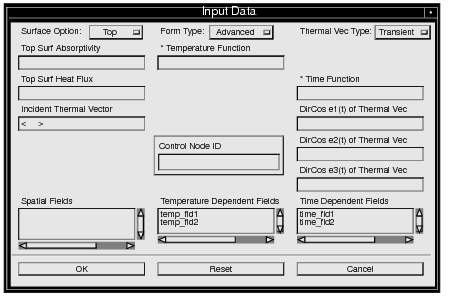
Incident Thermal Vector
The incident thermal vector defines the direction from the surface to the heat source. In steady-state analysis, you may use any of the standard Patran vector tools to define this vector. In a transient analysis, two options are available and controlled with the Thermal Vec Type menu:
1. If only the magnitude of the heat flux changes as a function of time in the analysis, you may choose Thermal Vec Type Constant and select a previously defined field in the * Time Function databox to describe this change.
2. If the direction of the vector also changes as a function of time, the Thermal Vec Type menu must be set to Transient. The form changes to display three databoxes titled DirCos ei(t) of Thermal Vec. Separate time-dependent fields can be selected for these three boxes to define the change of direction as a function of time.
The following table describes the options for the forms shown on
page 77 through
page 78.
Input Data | Dependence | Description |
Absorptivity | spatial, temp | Defines the absorptivity of the surface. |
[Top Surf, Bottom Surf, Edge] Absorptivity | spatial, temp | When the target element type is 2D, a toggle and databox appear to define the absorptivity of the top, bottom, or edge of a boundary surface. |
Heat Flux | spatial, time | Defines the heat flux quantity. |
[Top Surf, Bottom Surf, Edge] Heat Flux | spatial, time | When the target element type is 2D, a toggle and databox appear to define a heat flux applied on the top, bottom, or edge of a boundary surface. |
Incident Thermal Vector | -- | Defines the fixed direction incident thermal vector. |
DirCos e1(t) of Thermal Vec | time | Defines the time function of the direction cosine e1 of the incident thermal vector. |
DirCos e2(t) of Thermal Vec | time | Defines the time function of the direction cosine e2 of the incident thermal vector. |
DirCos e3(t) of Thermal Vec | time | Defines the time function of the direction cosine e3 of the incident thermal vector. |
Normal Vector | spatial | When the load type is Nodal or the target element type is 1D, a vector defining the “surface normal” must be entered. |
Nodal Area | -- | When the load type is Nodal, the area associated with the node must be entered. |
Control Node ID | -- | An advanced option that defines a control node. See Input Data Forms--Basic and Advanced Options, 69. |
Applied Heat--Nodal Source
This option applies a heat flow directly to one or more nodes in the model.
Input Data | Dependence | Description |
Nodal Source | spatial, time | Defines the heat applied to the nodes. |
Applied Heat--Volumetric Generation
This option defines a rate of heat generation within the volume of a conduction solid. This heat generation rate can be made a function of temperature by assigning a temperature field to the Heat Generation Multiplier option of the material associated with this solid.
Input Data | Dependence | Description |
Volumetric Heat Generation | spatial, time | Defines the volumetric heat generation in conduction elements. |
Control Node ID | -- | An advanced option that defines a control node. See Input Data Forms--Basic and Advanced Options, 69. |
Applied Heat--Total Heat
This option defines a rate of heat generation within the volume of a conduction solid. This heat generation rate can be made a function of temperature by assigning a temperature field to the Heat Generation Multiplier option of the material associated with this solid.
Input Data | Dependence | Description |
Total Heat | spatial, time | Defines the total heat (power) applied to a surface or element face. The total heat value given is divided by the total area of the application region (for surface entities). If the application region is geometry, then the value displayed graphically on the geometry is the actual given value. If the application region is FEM (or Geometry, but displayed on the associated FEM) then the value displayed is the given value divided by the total area of the application region. This is the value that will be written to the MD Nastran QBDY3 entry. |
Control Node ID | -- | An advanced option that defines a control node. See Input Data Forms--Basic and Advanced Options, 69. |
Convection--To Ambient
This option allows for the definition of the most basic form of convection boundary condition. Heat is exchanged between the surface of the body and a surrounding media, the temperature of which is known. The form for a steady-state load case and 2D element type are shown below.
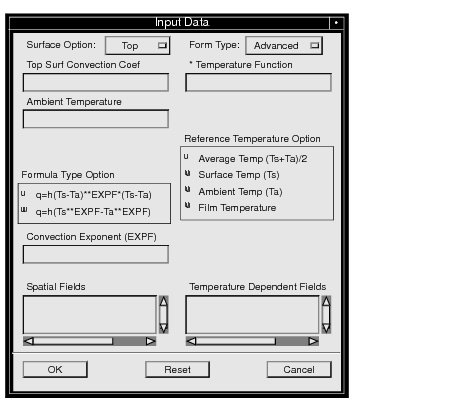
The options for this convection boundary condition are shown in the table below.
Input Data | Dependence | Description |
Convection Coefficient | spatial, temp, time | Defines free convection heat transfer coefficient. |
[Top Surf, Bottom Surf, Edge] Convection Coeff | spatial, temp, time | When the target element type is 2D, a toggle and databox appear to define the free convection heat transfer coefficient of the top, bottom, or edge of a boundary surface. |
Ambient Temperature | time | Defines ambient temperature. |
Nodal Area | -- | When the LBC type is Nodal, this databox appears to define the area of the boundary surface. |
Formula Type Option | -- | An advanced option for defining a customized form of the free convection formula: q = h (Ts-Ta)(expf+1) or q = h (Tsexpf - Taexpf) By default, the first form is chosen with EXPF equal 0.0. |
Convection Exponent | -- | An advanced option for defining EXPF in the above equation. |
Reference Temperature Option | -- | An advanced option for defining the temperature used in calculating the convection coefficient. The options are: average of surface and ambient temperatures, surface temperature, ambient temperature, or temperature at a user-defined node. By default, this reference temperature is taken as the average of surface and ambient temperatures. |
Film Node ID | -- | An advanced option for selecting an existing node for fluid film temperature. |
With MSC.Nastran Version 68, the Patran MD Nastran Forward Translator will average the values for Surface Temp (Ts) and Ambient Temp (Ta) to acquire the Average Temp (Ts+Ta)/2. Average Temp will be used as the temperature at which the temperature dependent heat transfer coefficient will be determined.
Convection--Flow Tube To Ambient
Two basic heat transport mechanisms take place when the Flow Tube element is used. The first involves the transport of heat in the streamwise direction from the upstream fluid elements to the downstream fluid elements. We refer to this as heat transport due to advection. The second heat transfer mechanism involves heat transport into or out of the working fluid along the fluid tube boundary. We refer to this as heat transfer due to forced convection.
The transport of heat energy by advection is a function of the mass flow rate (mdot) and the specific heat of the fluid. In the typical case we can ignore the small amount of heat transfer resulting from conduction in the fluid; energy is then transported at the rate: mdot * Cp * T. The heat transfer at the stream tube boundary, then, must be equal to (mdot * Cp * T)in - (mdot * Cp * T)out, where in and out refer to the inlet and exit states of the fluid stream. Typically, the inlet temperature is specified and the exit temperature is determined as part of the solution.
The forced convection part of the problem allows the fluid stream tube to communicate with the surrounding environment. You can determine the heat transfer coefficient for a particular problem externally, or use the generalized correlations available through the preference and MD Nastran heat transfer solver. The particular application has a lot to do with the viability of either approach.
A practical example of the use of Flow Tube to Ambient is the situation of analyzing a flow tube in a free stream of large mass flow and essentially constant temperature. A flow tube in an automobile radiator is a good example where the flow tube models the flow stream in the tubing (engine coolant) and the ambient environment is that of the air rushing across the tubes at the local air temperature.
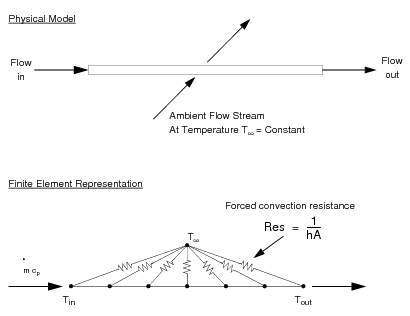
The Input Data form for a transient load case is shown below.
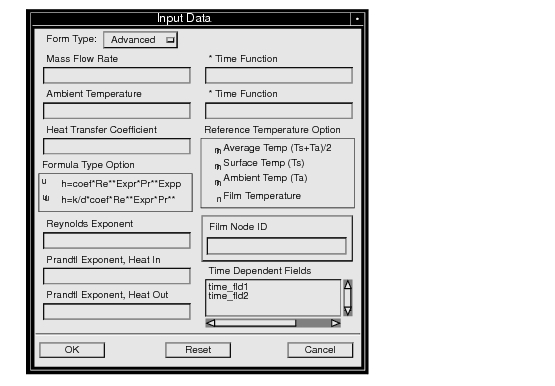
The following table describes the options for defining this convection boundary condition.
Input Data | Dependence | Description |
Mass Flow Rate | time | Defines mass flow rate within the flow tube element. |
Ambient Temperature | time | Defines ambient temperature. |
Heat Transfer Coefficient | -- | Defines the constant coefficient used for forced convection. A default value 1.e-20 will be defined if this data is not specified. |
Formula Type Option | -- | An advanced option to define forced convection formula type: h=coef*Reexpr*Prexpp or h=coef*Reexpr*Prexpp*k/d By default, the first form is chosen with EXPR and EXPP equal to 0.0. |
Reynolds Exponent | -- | An advanced option to define the Reynolds number convection exponent EXPR. |
Prandtl Exponent, Heat In | -- | An advanced option to define the Prandtl number convection exponent EXPPI for heat transfer into the working fluid. |
Prandtl Exponent, Heat Out | -- | An advanced option to define the Prandtl number convection exponent EXPPO for heat transfer out of the working fluid. |
Reference Temperature Option | -- | An advanced option for defining the temperature used in calculating material properties for the fluid. The options are: average of surface and ambient temperatures, surface temperature, ambient temperature, or temperature at a user-defined node. By default, this reference temperature is taken as the average of surface and ambient temperatures. |
Film Node ID | -- | An advanced option for selecting an existing node for fluid film temperature. |
With MSC.Nastran Version 68, the Patran MD Nastran Forward Translator will average the values for Surface Temp (Ts) and Ambient Temp (Ta) to acquire the Average Temp (Ts+Ta)/2. Average Temp will be used as the temperature at which the temperature dependent heat transfer coefficient will be determined.
Convection--Coupled
This advanced option for applying a convection boundary condition allows for the explicit definition of the convecting surface (Application Region 1) and a set of nodes (Application Region 2) between which heat is exchanged by convection. Mathematically, the exchange mechanism is similar to that for Convection to Ambient, except here Application Region 2 may be something other than basic ambient fluid points and their temperatures need not be specified in the description of the problem. The temperatures in Application Region 2 may be part of the solution. In addition, there does not need to be a one-to-one correspondence between nodal points in Region 1 and those in Region 2. The Input Data form for a steady-state load case is shown below.
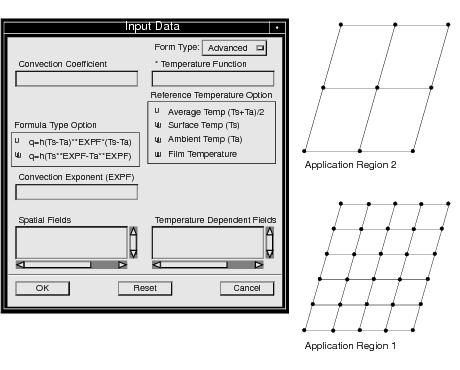
The input options for coupled convection are shown in the table below.
Input Data | Dependence | Description |
Convection Coefficient | spatial, temp, time | Defines free convection heat transfer coefficient. |
[Top Surf, Bottom Surf, Edge] Convection Coeff | spatial, temp, time | When the target element type is 2D, a toggle and databox appear to define the free convection heat transfer coefficient of the top, bottom, or edge of a boundary surface. |
Nodal Area | -- | When the LBC type is Nodal, this databox appears to define the area of the boundary surface. |
Formula Type Option | -- | An advanced option for defining a customized form of the free convection formula: q = h (Ts-Ta)(expf+1) or q = h (Tsexpf - Taexpf) By default, the first form is chosen with EXPF equal 0.0. |
Convection Exponent | -- | An advanced option for defining EXPF in the above equation. |
Reference Temperature Option | -- | An advanced option for defining the temperature used in calculating the convection coefficient. The options are: average of surface and ambient temperatures, surface temperature, ambient temperature, or temperature at a user-defined node. By default, this reference temperature is taken as the average of surface and ambient temperatures. |
Film Node ID | -- | An advanced option for selecting an existing node for fluid film temperature. |
With MSC.Nastran Version 68, the Patran MD Nastran Forward Translator will average the values for Surface Temp (Ts) and Ambient Temp (Ta) to acquire the Average Temp (Ts+Ta)/2. Average Temp will be used as the temperature at which the temperature dependent heat transfer coefficient will be determined.
Convection--Coupled Flow Tube
This is an advanced extension of the Convection, Flow Tube to Ambient boundary condition. In this application, the advection flow tube is attached to nodal points associated with a structure as opposed to simply an ambient environment. The flow tube in this application transports energy downstream in the mdot * C
p * T sense. Flow tube relations related to forced convection heat transfer at the tube boundaries are associated with this model. In this case, the convection area is the area associated with the flow tube perimeter, and it is the user’s responsibility to coordinate this area with that of the attached structure. It is important to realize that if the flow tube relationships are used (as opposed to a user-supplied h), the tube input diameters are used in the calculation of the Reynolds number and subsequently in calculating the heat transfer coefficient.
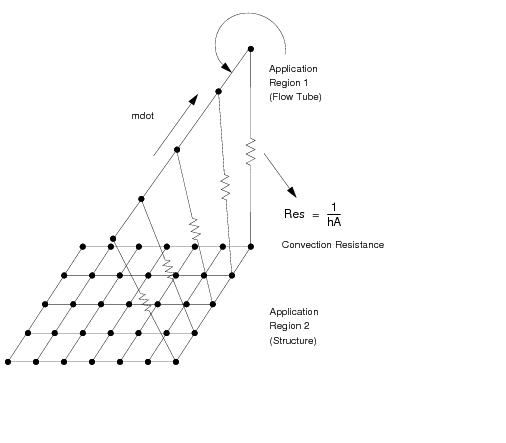
When this capability is applied, there must be general correspondence (one flow tube element for every structural element grid point pair) between the flow tube node points in Application Region 1 and the structural node points in Application Region 2. The Input Data form for a steady-state load case is shown below.
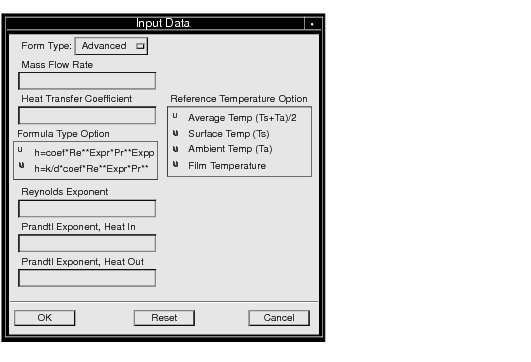
The input options for coupled flow tube convection are described in the table below.
Input Data | Dependence | Description |
Mass Flow Rate | time | Defines mass flow rate in the Flow Tube element. |
Heat Transfer Coefficient | -- | Defines the constant coefficient used for forced convection. A default value 1.e-20 will be defined if this data is not specified. |
Formula Type Option | -- | An advanced option to define forced convection formula type: h=coef*Reexpr*Prexpp or h=coef*Reexpr*Prexpp*k/d By default, the first form is chosen with EXPR and EXPP equal to 0.0. |
Reynolds Exponent | -- | An advanced option for defining the Reynolds number convection exponent EXPR in the above equation. |
Prandtl Exponent, Heat In | -- | An advanced option for defining the Prandtl number convection exponent EXPPI for heat transfer into the working fluid. |
Prandtl Exponent, Heat Out | -- | An advanced option for defining the Prandtl number convection exponent EXPPO for heat transfer out of the working fluid. |
Reference Temperature Option | -- | An advanced option for defining the temperature used in calculating material properties for the fluid. The options are: average of surface and ambient temperatures, surface temperature, ambient temperature, or temperature at a user-defined node. By default, this reference temperature is taken as the average of surface and ambient temperatures. |
Film Node ID | -- | An advanced option for selecting an existing node for fluid film temperature. |
With MSC.Nastran Version 68, the Patran MD Nastran Forward Translator will average the values for Surface Temp (Ts) and Ambient Temp (Ta) to acquire the Average Temp (Ts+Ta)/2. Average Temp will be used as the temperature at which the temperature dependent heat transfer coefficient will be determined.
Convection--Coupled Advection
This advanced option enables the connection between an advection stream and a structural surface. For this capability, the forced convection tube relationships are essentially turned off by setting the constant coefficient for forced convection to 1.E-20. The convection connection between the flow stream and the surface is determined from basic convection; Q = h * A * (T1 - T2). Here the internally calculated area A is the area associated with the structural surface elements. The user must specify the value of the heat transfer coefficient, h. In steady-state analysis, the flow tube diameters are of little consequence for this capability since no Reynolds Numbers or heat transfer coefficients are determined internally. In transient analysis, the fluid speed needs to be produced by the correct choice of fluid properties and tube diameter. There need not be any particular correspondence between the nodes on the flow tube and those on the surface elements; Patran uses a closest approach algorithm to associate the surface elements with the stream tube elements. The Input Data form for a steady-state load case is shown below.
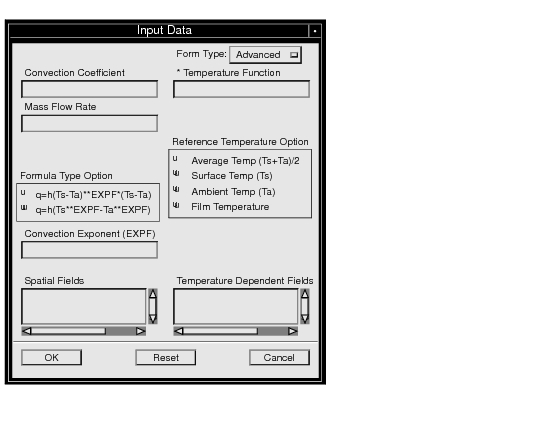
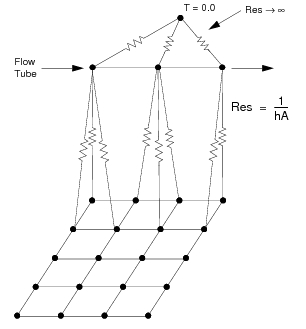
In MD Nastran terms, the flow tube ambient points are brought together and set to 0.0 degrees temperature. The forced convection resistance is set to a large number (negligible heat transfer coefficient). The connection between the fluid and structure is affected through basic convection with a user-specified heat transfer coefficient. The input options are described in the table below.
Input Data | Dependence | Description |
Convection Coefficient | spatial, temp, time | Defines free convection heat transfer coefficient. |
[Top Surf, Bottom Surf, Edge] Convection Coeff | spatial, temp, time | When the target element type is 2D, a toggle and databox appear to define the free convection heat transfer coefficient of the top, bottom, or edge of a boundary surface. |
Mass Flow Rate | time | Defines the mass flow rate of the flow tube elements. |
Nodal Area | -- | When the LBC type is Nodal, this databox appears to define the area of the boundary surface. |
Formula Type Option | -- | An advanced option for defining a customized form of the free convection formula: q = h (Ts-Ta)(expf+1) or q = h (Tsexpf - Taexpf) By default, the first form is chosen with EXPF equal 0.0. |
Convection Exponent | -- | An advanced option for defining EXPF in the above equation. |
Reference Temperature Option | -- | An advanced option for defining the temperature used in calculating the convection coefficient. The options are: average of surface and ambient temperatures, surface temperature, ambient temperature, or temperature at a user-defined node. By default, this reference temperature is taken as the average of surface and ambient temperatures. |
Film Node ID | -- | An advanced option for selecting an existing node for fluid film temperature. |
With MSC.Nastran Version 68, the Patran MD Nastran Forward Translator will average the values for Surface Temp (Ts) and Ambient Temp (Ta) to acquire the Average Temp (Ts+Ta)/2. Average Temp will be used as the temperature at which the temperature dependent heat transfer coefficient will be determined.
Convection--Duct Flow
This feature enables the user to associate a 1D fluid stream with a surface or duct composed of 2D or 3D (shell or solid) elements. When specifying the duct flow attributes, the target element type is 1D and the region-2 specification will be 2D or 3D. It would be good modeling practice to provide flow stream element discretization level of approximately the same level as the adjoining structure with respect to the streamwise direction. Fluid connections can only be made between the flow tube and 3 noded triangular elemental surfaces or 4 noded quadrilateral elemental surfaces.
The structural surface may represent a physically more complex geometry composed of surface fins. The increased area associated with extended surfaces can be accounted for in duct flow by using the Extended Surface Multiplier on the Input Data menu. The actual convection surface area will equal the area calculated by the code from the elemental areas times this surface multiplier. On this same menu, mass flow rate refers to the duct mass flow rate (total flow).
The proper treatment of the heat transfer coefficient relationship depends on the input for the flow tube diameters, defined in this application as the hydraulic diameters (DH). The flow tube hydraulic diameter is the dimension used in internally calculating the Reynolds Number. It will also automatically be used as the diameter in the Input Data, Formula Type Option equation for the heat transfer coefficient. With this formulation, the advection flow heat transfer coefficient is based on the gross dimensions of the structure and is input to the code through the input of hydraulic diameter. It is the user’s responsibility to determine an appropriate DH. The mass flow rate and fluid material properties represent the actual total/real flow characteristics for the duct. The actual elemental surface area flow attachment is accounted for internally through the triangle and quadrilateral surface element area calculations and may be enhanced by the extended surface multiplier to represent a finned surface.
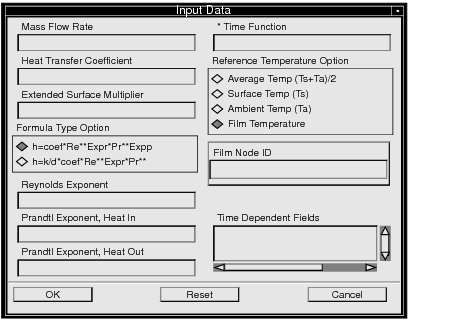
Input Data | Dependence | Description |
Mass Flow Rate | time | Defines mass flow rate in the Flow Tube element. |
Heat Transfer Coefficient | -- | Defines the constant coefficient used for forced convection. A default value 1.e-20 will be defined if this data is not specified. |
Extended Surface Multiplier | -- | Defines extended area factor for surface fins. |
Formula Type Option | -- | An advanced option to define forced convection formula type: h=coef*Reexpr*Prexpp or h=coef*Reexpr*Prexpp*k/d By default, the first form is chosen with EXPR and EXPP equal to 0.0. |
Reynolds Exponent | -- | An advanced option for defining the Reynolds number convection exponent EXPR in the above equation. |
Prandtl Exponent, Heat In | -- | An advanced option for defining the Prandtl number convection exponent EXPPI for heat transfer into the working fluid. |
Prandtl Exponent, Heat Out | -- | An advanced option for defining the Prandtl number convection exponent EXPPO for heat transfer out of the working fluid. |
Reference Temperature Option | -- | An advanced option for defining the temperature used in calculating material properties for the fluid. The options are: average of surface and ambient temperatures, surface temperature, ambient temperature, or temperature at a user-defined node. By default, this reference temperature is taken as the average of surface and ambient temperatures. |
Film Node ID | -- | An advanced option for selecting an existing node for fluid film temperature. |
Radiation--Ambient Space
This option defines a boundary condition for a surface exchanging radiant energy with an ambient temperature in space. The Input Data form for 3D element types is shown below.
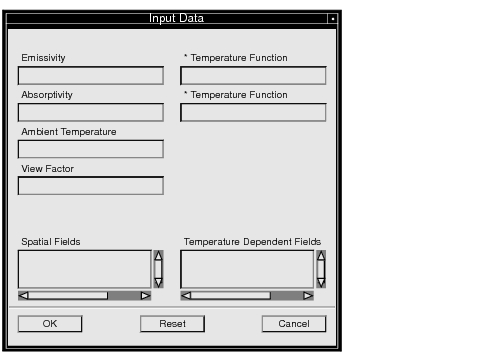
Input Data | Dependence | Description |
Emissivity | spatial, temp | Defines surface emissivity. |
[Top Surf, Bottom Surf, Edge] Emissivity | spatial, temp | When the target element type is 2D, a toggle and databox appear to define the emissivity of the top, bottom, or edge of a boundary surface. |
Absorptivity | spatial, temp | Defines surface absorptivity. |
[Top Surf, Bottom Surf, Edge] Absorptivity | spatial, temp | When the target element type is 2D, a toggle and databox appear to define the absorptivity of the top, bottom, or edge of a boundary surface. |
Ambient Temperature | time | Defines ambient temperature. |
View Factor | spatial, time | Defines radiation view factor between the surface and the ambient space. The default value is 1.0. |
Nodal Area | -- | When the LBC type is Nodal, this databox appears to define the area of the boundary surface. |
Radiation--Ambient Nodes
This is an advanced option for applying a radiation boundary condition to a surface. You select both the surface (Application Region 1) and a set of nodes that define the temperature to which the surface is exchanging heat by radiation (Application Region 2).
Input Data | Dependence | Description |
Emissivity | spatial, temp | Defines surface emissivity. |
[Top Surf, Bottom Surf, Edge] Emissivity | spatial, temp | When the target element type is 2D, a toggle and databox appear to define the emissivity of the top, bottom, or edge of a boundary surface. |
Absorptivity | spatial, temp | Defines surface absorptivity. |
[Top Surf, Bottom Surf, Edge] Absorptivity | spatial, temp | When the target element type is 2D, a toggle and databox appear to define the absorptivity of the top, bottom, or edge of a boundary surface. |
View Factor | spatial, time | Defines radiation view factor between the surface and the ambient nodes. The default value is 1.0. |
Nodal Area | -- | When the LBC type is Nodal, this databox appears to define the area of the boundary surface. |
Radiation--Enclosures
This option defines a radiation boundary among a set of surfaces making up a cavity or enclosure. Each surface is defined independently using the form below. The surfaces are grouped to form an enclosure by specifying the same Enclosure ID (integer) on all surfaces making up the enclosure.
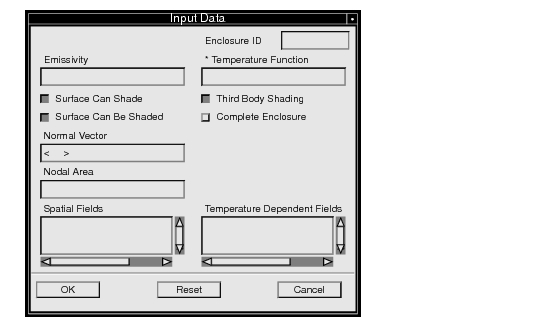
Input Data | Dependence | Description |
Enclosure ID | -- | Defines the ID number of the radiation enclosure. |
Emissivity | spatial, temp | Defines surface emissivity. |
[Top Surf, Bottom Surf, Edge] Emissivity | spatial, temp | When the target element type is 2D, a toggle and databox appear to define the emissivity of the top, bottom, or edge of a boundary surface. |
Surface Can Shade | -- | Specifies if the face can shade other faces in the enclosure (default=yes). |
Surface Can Be Shaded | -- | Specifies if the face can be shaded by other faces in the enclosure (default=yes). |
Normal Vector | spatial | When the load type is Nodal or the target element type is 1D, a vector defining the “surface normal” must be entered. |
Nodal Area | -- | When the LBC type is Nodal, this databox appears to define the area of the boundary surface. |
Third Body Shading | -- | Controls third body shading calculation (default=yes). When set at “no,” third body shadowing calculations will be ignored. |
Complete Enclosure | -- | In an enclosure that is not fully closed, energy may be radiated to entities outside the enclosure. Toggling this option from “no” (default) to “yes” specifies that all energy not exchanged among the surfaces of the enclosure will be radiated to a user-defined ambient temperature. When creating an enclosure it is sometimes not feasible to model everything that will be generating or receiving heat from a model. The user models everything that is of interest, and then simply wants to close the remainder of the his model with a single ambient element that will allow his view factors to sum to 1.0. This is done with a RADCAV card and can be accomplished by selecting the complete enclosure toggle. The ambient temperature of the open space is then entered, and now the analysis is able to complete with a total view factor of 1.0. |
Ambient Temperature | -- | This databox appears when the Complete Enclosure option is toggled to “yes” and is used to define the external temperature to which energy is exchanged with the enclosure. |
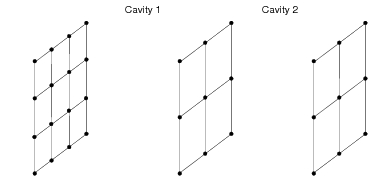
Figure 3‑5 Multiple Cavity Example
Figure 3‑6 Single Cavity Example
